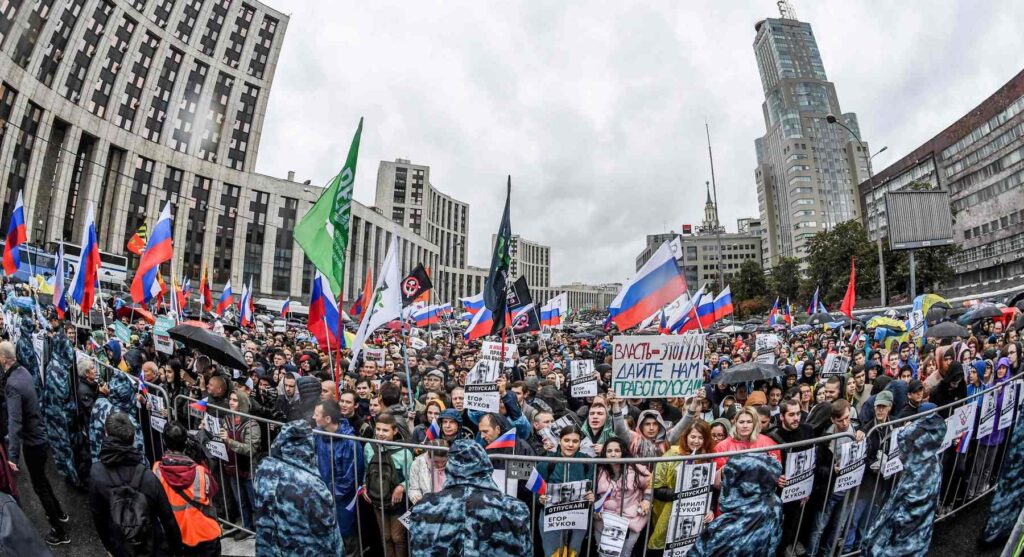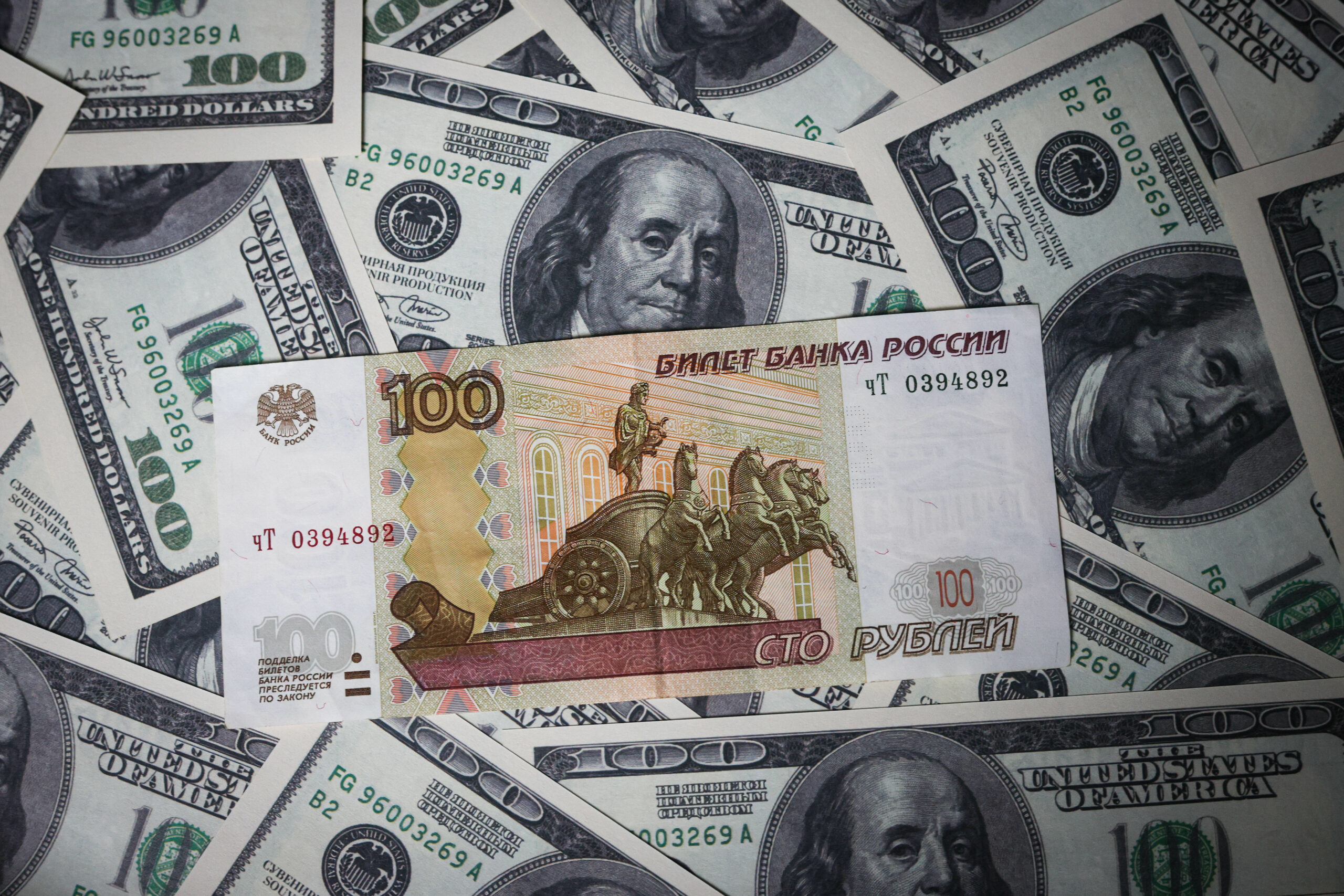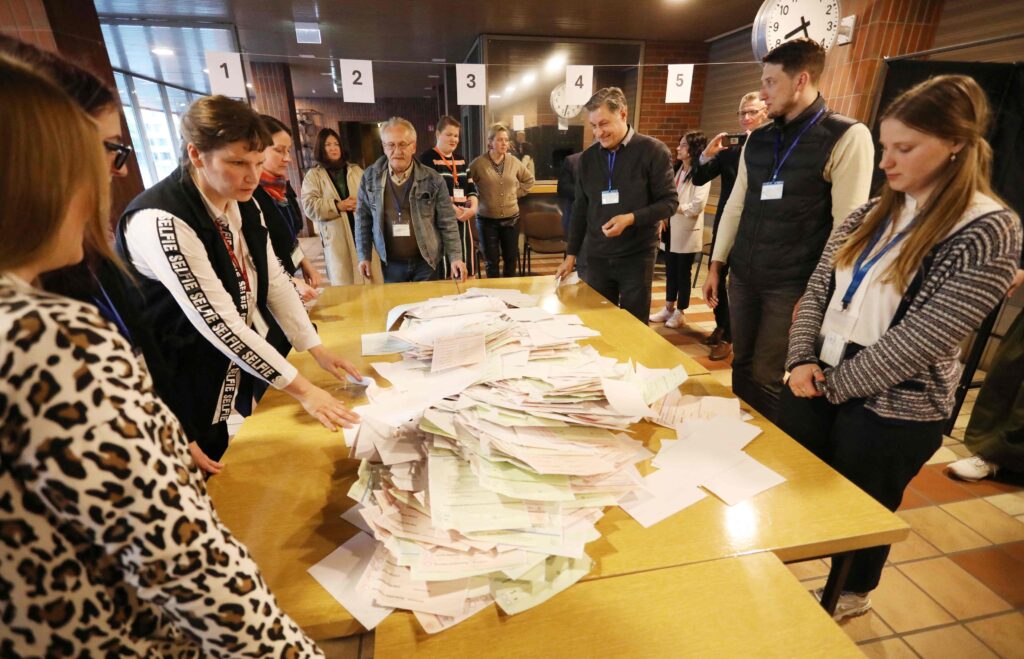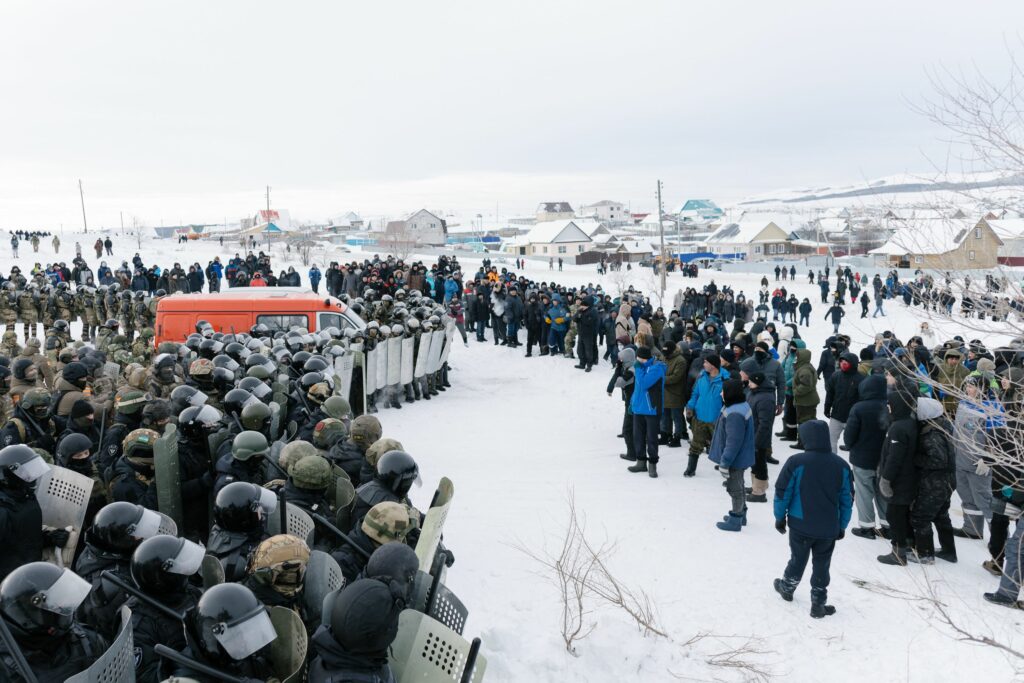Two significant public uprisings recently took place in the post-Soviet space: large-scale protests in Belarus, which began after the scandal-filled presidential elections, and the change of power in Kyrgyzstan. In this context, some observers once again recalled the “colour revolutions” while others began to extrapolate the Belarusian events onto Russia.
The “colour revolutions” as well as electoral revolutions which triggered a change of political leaders or, in some cases, a change of regime, were actively debated back in the early 2000s. The events in Georgia and Ukraine played a fatal role for the Russian civil society and political institutions: the authorities started a preventive fight against an invisible threat. By doing so, they effectively throttled the remnants of civil autonomy. In 2011–2012, a large-scale mobilisation against electoral fraud rolled out across Russia’s largest cities. To a large extent, these very protests led to further tightening of the political regime and “tightening the screws.” After 2014, the rhetoric of the “orange threat” dissolved into popular geopolitics: opposition protests lost a direct connection to the electoral agenda while federal elections no longer allow the illusion of elections that would “tip the balance.” The opposition shifted its attention to local elections.
However, “colour revolutions” are a rather misleading metaphor. Firstly, a revolutionary change of power often occurs without any connection to elections (Kyrgyzstan in 2010, Euromaidan in 2013). Secondly, most post-election protests do not lead to a change of power. For instance, protests in Russia in 2011–2012, or numerous spates of protests in Belarus since the early 2000s. At the same time, Russian propagandists did not attach a label of a “colour revolution” to the 2018 protests in Armenia. One might conclude that the term “colour revolutions” is used only to refer to those changes of power or regime that are not liked by the Russian authorities.
If we leave the world of propaganda and shift to serious analysis instead, we should remember that the outdated rhetoric of “colour revolutions” and electoral revolutions distorts our idea of the prospects and mechanisms of election-related protests. In fact, elections and revolutions are not too closely intertwined. While the Russian authorities see all elections as a source of potential threat, this ironically awakens hopes that elections will bring about an unexpected regime change through mass protests.
How is that related to the 2021 elections? The recent All-Russian Civil Forum discussed the prospects of a popular rebellion against the backdrop of the deteriorating economic situation and a steady decline in the quality of electoral legislation and the electoral procedures in Russia. There is hardly any doubt among the expert community that the pandemic and economic recession will have a negative impact on the degree of support for the ruling party in 2021, and some even expect the situation to trigger mass protests and escalation of violence in accordance with the Belarusian scenario.
Let us try to understand the learnings from the many years of research into protest movements and elections in authoritarian regimes. By understanding the mechanisms of mobilisation, it will be easier for us to formulate realistic expectations for the upcoming elections.
Six myths about elections and protests in autocracies
Myth 1: Protests are triggered by the most rigged elections
The phenomenon of “critical citizens” has long been established in democratic countries: even when procedures and institutions work normally, there will always be citizens who are dissatisfied with some aspects of their work. The more open the political process, the greater the number of such citizens. This is exactly the mechanism that underpins accountability.
In regimes where accountability is problematic, falsifications and violations rarely lead to protests. According to my own estimates, only 25% of elections in electoral authoritarian regimes ended in protests in 1990–2011. Protests occur primarily where people know how to detect violations and what kind of violations to expect; where people believe that violations are likely and where they are willing to spread the news about violations. The first two conditions are necessary yet not sufficient. The third one reinforces the mobilisation that has already begun to seethe.
A few years ago, my colleagues and I compared the number of reported violations with the “Map of violations” developed by the “Golos” movement (i.e. subjective ratings of the quality of elections) against a measure used to diagnose violations, i.e. the link between electoral turnout and the number of votes for the winner (an objective token of quality). By using the example of the Tyumen Oblast and the Perm Oblast, we found that the connection between those indicators is either non-existent or totally negative. Voters are more likely to complain about violations in more competitive regions rather than in politically closed regions. However, independent observers can only carry out their observations where they are admitted, while observations are restricted to the minimum in closed hegemonic regions where the scale of ballot-box stuffing and controlled voting is greater (e.g. the Tyumen Oblast). In other words, the diagnostician cannot examine the patients who have the most acute symptoms.
The theme of dignity plays a considerable role in protests: outright falsification (“dead souls” on voter lists, manipulations with voting reports and illegal campaigning on voting day) become part of voters’ personal experience and are seen at best as disrespect for citizens, and at worst as a theft of their votes. This can make voters angry, and not only the critical ones but also those who are neutral or even loyal to the current government.
Myth 2: Protests can be controlled from the outside / protests entail a technology
In most cases, large-scale protests are not fully spontaneous. Any mobilisation is preceded by some kind of preliminary work and a favourable confluence of circumstances (a window of political opportunity). However, this does not mean that protests can be programmed and managed using the “Gene Sharp method.” This misconception should be left to those responsible for the state propaganda.
The coordination and operation of organisational structures of citizens’ associations and political forces on the eve of the elections is a prerequisite for at least minimal mobilisation. Observable violations are not sufficient to trigger mass protest and people must “learn” to identify them. The educational and awareness-raising work of professional observers, experts and activists plays a crucial role in this sphere. It is important to understand that this is not a question of “importing technologies” from the outside. What plays the key role is domestic demand and the timely supply of expertise in the field of voter rights protection. On the eve of the elections in Belarus, the civil society and the headquarters of opposition candidates did some serious work. However, large-scale protests are often described as decentralised, without a common coordination centre.
Some time ago, it was trendy to talk about the export of “colour” (or electoral) revolutions. This technology is allegedly roaming from country to country through NGOs, youth organisations and observers. It is thought to move from Serbia to Georgia, and from there to Ukraine. In reality, however, the key role is still played by the domestic political forces, their resources and strategies. Protesters can indeed be inspired by the example of their neighbours. This is what researcher Kurt Weyland once called “heuristics of similarity”: it seems that the conditions in the neighbouring country are similar, and if there is a possibility of change there, then we also have some potential. However, this does not mean that the initial conditions and the structure of opportunities are the same. This is why every subsequent protest wave in another country is less successful than the previous one. At the same time, we should not forget that political elites are equally skilled at learning from other countries’ examples.
Myth 3: Only the opposition and idealists go out to protest against unfair elections
In the post-communist world, the level of political participation is generally lower, which is often understood as fatigue caused by constant ritual mobilisation and a lack of belief that these actions will produce some results. Those involved in public activities are perceived as naive or irrational.
Any protest consists of a core (“true believers”) and more peripheral participants, and the number of the latter is crucial to the success of the protest movement. Research by the “Za chestnye vybory” (For Fair Elections) movement found that in December 2011, the Sakharov Avenue saw a very diverse group of participants, far from being just convinced oppositionists. Procedural legitimacy did indeed play an important role in attracting peripheral participants, who were outraged by the scale of violations and outright disrespect for participants in the electoral process. Overall, a protest is a very pragmatic strategy for the opposition and civil society associations, which signals the number of dissenters and normalises an alternative vision for the elections. Opposition and protests are often joined by dissatisfied careerists who have not found a place for themselves in the existing power structures or in numerous satellite parties. The increasing number of such people is a true signal of a deep crisis of the regime’s co-opting power.
Myth 4: If voters go to “bad” elections regularly, they will gradually learn to use them and the elections will eventually become “normal”
This logic is akin to “the theory of small things” or the proverb about water that weathers the stone (meaning: little by little does the trick). A collection of studies on electoral processes in authoritarian regimes, edited by Staffan Lindberg (“Democratisation by Elections”), was published in 2009. Based on the material on elections in Sub-Saharan Africa, Lindberg himself argued that if one tries to participate in openly unfair elections for a long time, sooner or later this institution will work properly and opportunities for peaceful democratic transition through elections will open up. The author calls this the “learning effect.” Alas, this argument has an important flaw, not to mention a light post-colonial flavour. The transformation of a regime is not the result of elections as an “external shock” since the electoral timetable is carefully designed in both democracies and autocracies, but rather as a result of a fundamental change in the balance of power between the opposition and the ruling elite, and the formation of new coalitions. In this context, election campaigns serve as a signal to all stakeholders.
Myth 5: With the existing institutions, it makes no sense for dissenters to take part in elections
When one wonders what to do with bad institutions and regimes, sooner or later two polar strategies will emerge: to boycott the existing institutions and await a revolution, or to hope for their gradual improvement. Electoral institutions in Russia are being undermined at a more fundamental level, so no cosmetic changes will lead to an improvement in the quality of electoral processes. However, this does not mean that absenteeism and boycott are the only strategy (in some cases, this approach is even embraced by the incumbent, as it demobilises the protesting electorate and reduces the cost of ensuring the right result).
In 2021, the Russian opposition will try to use Smart Voting (SV) system to inflict tangible damage on United Russia. According to Grigory Golosov and Mikhail Turchenko, Smart Voting does not only give candidates an additional 7% of the vote and reduces support for pro-government candidates, but also gives a new meaning to the voting procedure by attracting voters to polling stations. As voters make greater investments in voting, they will also be more determined to assert their rights. The struggle will get harder for United Russia in single-seat constituencies in 2021. At the same time, even if SV does not work properly, it will nevertheless lead to mobilisation and more effective dissemination of information on violations. And, as we know, United Russia’s success is based on low turnout.
Myth 6: Electronic voting will make the voting process more open and accessible
As long as the fundamental issues are not resolved, i.e. the admission of alternative candidates for elections and the registration of political parties that have not been agreed in advance with the authorities, no additional technological tricks can make the election process more open, let alone more democratic. In the context of an authoritarian electoral regime, the introduction of electronic voting should only be seen as another strategy to reduce the cost of securing the right number of votes for the incumbent. Electronic voting has simply been added to the traditional sore spots such as absentee ballots and pre-poll voting.
***
The 2021 Duma elections will not be held in particularly comfortable conditions for United Russia. The situation is complicated by the economic consequences of the pandemic and the overall decline in support for the institutions of power. According to representative online surveys, in the summer of 2020 the respondents were extremely sensitive to economic fluctuations and expressed a high degree of concern (while being slightly less concerned about the pandemic). In the eyes of voters, the Duma is the most disliked body of federal power, which is why it will be difficult for United Russia to maintain its current number of mandates. However, no serious opponents will be allowed to participate in the elections anyway. And the probability of protests will largely depend on the strategies employed by the opposition and the degree of its organisation.










